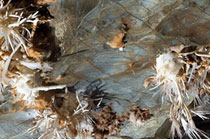Ochtinská aragonite cave

Ochtinská aragonite cave
The cave is located in the Ochtinsky cryptocrater on the north-western slope of Hrádek in the Revúca Upland between Jelšava and Štítnik. The access tunnel leads into the cave at an altitude of 642 m.
It is formed in a lens of first-age Lower Devonian crystalline limestones and ankerites situated in the middle of non-crustal rocks - phyllites. The wedge-shaped, upwardly tapering passages and halls were formed by the corrosive action of precipitation water that seeped along distinct tectonic faults. The distinct, predominantly horizontal corridors and halls are between parallel tectonic faults. They were formed mainly by the corrosive action of slow-moving water as a result of mixing of waters of different temperatures and chemical composition, as indicated by the many irregular niches and ceiling domes. Corrosion-aligned ceilings (the lower parts of the ceiling domes have been cut away) and lateral corrosion notches on the rock walls have formed along the former water level, which has dropped and stagnated for a long time.
 Three generations of aragonite were found in the cave. The oldest are milky cloudy kidney-shaped formations and their corroded remains (dated at 121- to 138-thousand years old) with partially recrystallized aragonite, locally converted to calcite. The second generation of aragonite is the most abundant, occurring as several dm long needles and curved to spiral helictites (dated age 14 thousand years). These form clustered or bush-like formations (including the so-called iron flower), which are most attractive to visitors. The second-generation aragonite is still growing, thus retaining its white colour and clean appearance. The youngest generation of aragonite, which now forms on sediments and iron ochres, produces tiny fans (2 to 4 mm in size, sometimes larger), and occasionally miniature spiral formations.
Three generations of aragonite were found in the cave. The oldest are milky cloudy kidney-shaped formations and their corroded remains (dated at 121- to 138-thousand years old) with partially recrystallized aragonite, locally converted to calcite. The second generation of aragonite is the most abundant, occurring as several dm long needles and curved to spiral helictites (dated age 14 thousand years). These form clustered or bush-like formations (including the so-called iron flower), which are most attractive to visitors. The second-generation aragonite is still growing, thus retaining its white colour and clean appearance. The youngest generation of aragonite, which now forms on sediments and iron ochres, produces tiny fans (2 to 4 mm in size, sometimes larger), and occasionally miniature spiral formations.







